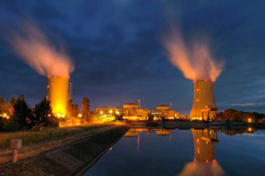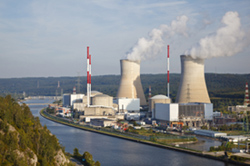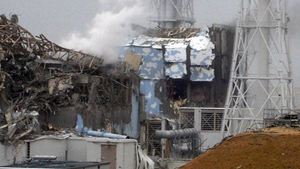Nuclear Disaster
A nuclear and radiation accident is defined by the International Atomic Energy Agency
as "an event that has led to significant consequences to people, the environment
or the facility. Examples include lethal effects to individuals, large radioactivity
release to the environment, or reactor core melt."The prime example of a "major
nuclear accident" is one in which a reactor core is damaged and significant amounts
of radiation are released, such as in the Chernobyl Disaster in 1986. The impact
of nuclear accidents has been a topic of debate practically since the first nuclear
reactors were constructed. It has also been a key factor in public concern about
nuclear facilities.Some technical measures to reduce the risk of accidents or to
minimize the amount of radioactivity released to the environment have been adopted.
Despite the use of such measures, "there have been many accidents with varying impacts
as well near misses and incidents".
Impact
Benjamin K. Sovacool has reported that worldwide there have been 99 accidents at
nuclear power plants.[5] Fifty-seven accidents have occurred since the Chernobyl
disaster, and 57% (56 out of 99) of all nuclear-related accidents have occurred
in the USA.Serious nuclear power plant accidents include the Fukushima Daiichi nuclear
disaster (2011), Chernobyl disaster (1986), Three Mile Island accident (1979), and
the SL-1 accident (1961).Stuart Arm states, "apart from Chernobyl, no nuclear workers
or members of the public have ever died as a result of exposure to radiation due
to a commercial nuclear reactor incident."Nuclear-powered submarine mishaps include
the K-19 reactor accident (1961),the K-27 reactor accident (1968),and the K-431
reactor accident (1985).Serious radiation accidents include the Kyshtym disaster,Windscale
fire, radiotherapy accident in Costa Rica,radiotherapy accident in Zaragoza,radiation
accident in Morocco,Goiania accident,radiation accident in Mexico City, radiotherapy
unit accident in Thailand,and the Mayapuri radiological accident in India.

Nuclear power plant accidents
One of the worst nuclear accidents to date was the Chernobyl disaster which occurred
in 1986 in Ukraine. That accident killed 30 people directly, as well as damaging
approximately $7 billion of property. A study published in 2005 estimates that there
will eventually be up to 4,000 additional cancer deaths related to the accident
among those exposed to significant radiation levels.Radioactive fallout from the
accident was concentrated in areas of Belarus, Ukraine and Russia. Approximately
350,000 people were forcibly resettled away from these areas soon after the accident.
Benjamin K. Sovacool has reported that worldwide there have been 99 accidents at
nuclear power plants from 1952 to 2009 (defined as incidents that either resulted
in the loss of human life or more than US$50,000 of property damage, the amount
the US federal government uses to define major energy accidents that must be reported),
totaling US$20.5 billion in property damages.Fifty-seven accidents have occurred
since the Chernobyl disaster, and almost two-thirds (56 out of 99) of all nuclear-related
accidents have occurred in the USA. There have been comparatively few fatalities
associated with nuclear power plant accidents. Nuclear reactors become preferred
targets during military conflict and, over the past three decades, have been repeatedly
attacked during military air strikes, occupations, invasions and campaigns.

Nuclear Safety
Nuclear safety covers the actions taken to prevent nuclear and radiation accidents
or to limit their consequences. This covers nuclear power plants as well as all
other nuclear facilities, the transportation of nuclear materials, and the use and
storage of nuclear materials for medical, power, industry, and military uses. The
nuclear power industry has improved the safety and performance of reactors, and
has proposed new safer (but generally untested) reactor designs but there is no
guarantee that the reactors will be designed, built and operated correctly.Mistakes
do occur and the designers of reactors at Fukushima in Japan did not anticipate
that a tsunami generated by an earthquake would disable the backup systems that
were supposed to stabilize the reactor after the earthquake.According to UBS AG,
the Fukushima nuclear accidents have cast doubt on whether even an advanced economy
like Japan can master nuclear safety. Catastrophic scenarios involving terrorist
attacks are also conceivable. An interdisciplinary team from MIT have estimated
that given the expected growth of nuclear power from 2005 – 2055, at least four
serious nuclear accidents would be expected in that period.To date, there have been
five serious accidents (core damage) in the world since 1970 (one at Three Mile
Island in 1979; one at Chernobyl in 1986; and three at Fukushima-Daiichi in 2011),
corresponding to the beginning of the operation of generation II reactors. This
leads to on average one serious accident happening every eight years worldwide.Nuclear
weapon safety, as well as the safety of military research involving nuclear materials,
is generally handled by agencies different from those that oversee civilian safety,
for various reasons, including secrecy. There are ongoing concerns about terrorist
groups acquiring nuclear bomb-making material.
